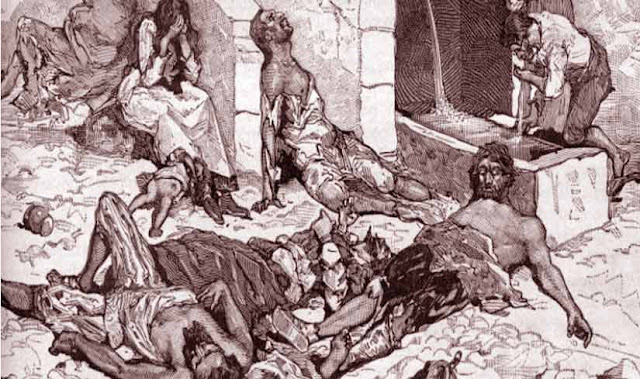
The Coronavirus has triggered a worldwide wave of fear, but despite all the evidence, the virus is not as dangerous as the fear it produces. The pandemics in history were even direr. History tells us that many times in the past, horrible outbreaks have wreaked havoc on the human population at large and that the current Coronavirus outbreak has no comparison.
Here we are referring to ten horrific, the deadliest pandemic outbreaks that have devastated many parts of the world. The lightest epidemic is on the first number, and the most terrible would be at the last.
10. Encephalitis lethargica, Sleeping Sickness, or Sleepy Sickness

The outbreak, which spread from 1915 to 1926, was caused by a germ that attacks the brain. This disease can be considered as a form of meningitis. The patient suffers severe drowsiness and may also experience abnormal eye movements, upper body weakness, tremors, muscular pains, neck rigidity, and behavioral changes. In the disease's severity, the patient remains like a statue and can not move.
9. Influenza Virus A, Asian Flu

From 1956 to 1958, the flu emerged from China that swept across the globe swiftly. According to some experts, the virus was transmitted from ducks to humans. Nearly two million people have been died by the outbreak, including 70,000 deaths in the United States alone.
8. The Persian Plague Epidemic

The plague has been raging from time to time, but in 1772 a devastating outbreak broke out in Iran. There was no cure for this deadly disease, which caused the whole country to wrap up.
7. Cocoliztli II Epidemic

When Spanish conquests invaded the continental United States, it led to a horrific tragedy of human history. There was no immune to European germs in the bodies of the local population, so their areas were devastated. A tragedy took place in Mexico between 1576 and 1580, killing 2 million to 2.5 million people. It is unclear what the original disease was, but patients had a high fever, and blood was released from different parts of the body.
6. Antonine Plague, Plague of Galen

The terror spread when the Roman Empire was at its peak. The epidemic which continued from 165 CE to 180 CE, disrupted large parts of Europe. The famous Aelius Galenus has lived in the same period and has given details of the disease. However, it was unclear about the disease. Scholars have suspected it to have been measles or smallpox.
5. Cocoliztli I Epidemic Or The Great Pestilence

The outbreak also occurred in Mexico, but about 30 years before Cocoliztli II, and the reason was the same. But the outbreak caused more resilience than the other and put the death toll of 5 million to 15 million people to death. The figures are terrifying in that the population was much smaller than it is today, and it can be imagined how it might have made the whole country barren.
4. Plague Of Justinian

This epidemic from 541 to 542 is the first major example of the plague. In two years the plague ravaged the Byzantine Empire and its adjoining Sasanian Empire like a flood. The impact of the outbreak was so severe that, according to experts, it changed the course of history. The epidemic is said to have weakened the empires so much that after a few decades, the Arabs easily overthrew the two.
3. HIV/AIDS (Human Immunodeficiency Virus Infection And Gained Immune Deficiency Syndrome)

HIV/AIDS has not been considered an old disease. Its virus transmitted from chimpanzees to humans in West Africa and then spread to the rest of the world. The disease has affected most of Africa and in recent years, over 60% of worldwide cases are from sub-Saharan Africa.
2. Spanish Flu, 1918 Flu Pandemic

The outbreak spread when the world was just buried under the rubble of the destruction of the First World War -1918 to 1920. The world's population was close to two billion, while the Spanish flu affected almost every fourth person.
The flu outbreak has been hidden in most parts of Europe because of the war situation, while Spain was not involved in the war, and from the news of the huge casualties there came to the impression that the disease was particularly targeted to Spain. The flu is usually fatal for children, and the elderly but the Spanish flu specifically kills young people.
1. Black Death, Great Bubonic Plague, Pestilence, The Great Plague, or The Plague

Human history has never suffered from such a great tragedy. The plague that plagued the world from 1347 to 1351 affected the world so much. It is said if this pandemic had not occurred, the world map would have been different today. Experts say that the plague germ flows from East Asia through trade routes to the Middle East and then to Europe, where it killed 30% to 60% of the population. The catastrophe was so dire that there was no room to bury the deceased. Corpses were left stacked in the open. Funeral rites were often left abandoned, and the whole city stank like the dead. For the first time in history, the entire population of the world has decreased because of the effects of this outbreak, and it took the world two hundred years to reach that level of population again.
EXTRA: The Deadliest Epidemic Of The 21st Century
The Ebola virus disease is also known as Ebola hemorrhagic fever (EHF) or Ebola spread to West Africa from 2013 to 2016 killed 11300 people, making it the deadliest outbreak of the century so far.
